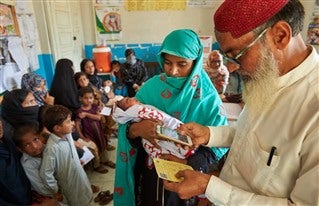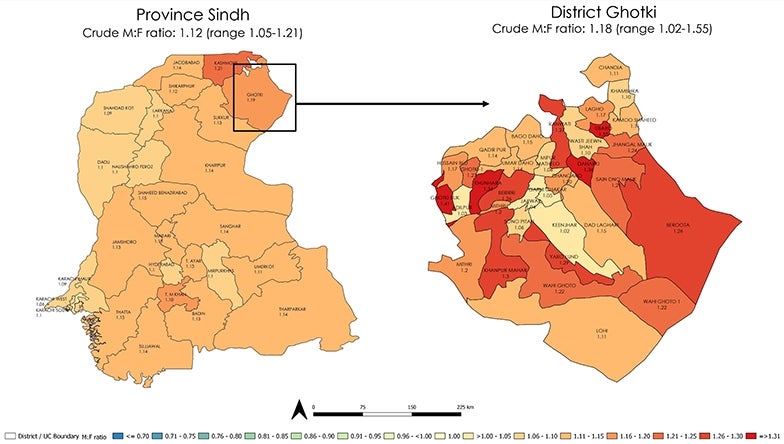Electronic Immunization Registry in Pakistan - Using Big Data to Achieve pre-COVID-19 Routine Immunization Rates and Address Gender Disparities
The COVID-19 pandemic is rapidly unraveling decades of global progress towards improving public health. Especially impacted are childhood immunization rates. The 2020 Goalkeepers Report[1] revealed that over the course of just 25 weeks, COVID-19 pushed vaccination rates down to levels last seen 25 years ago. The pandemic cut the proportion of children around the world receiving all recommended childhood vaccinations from a record high of 84 percent back down to 70 percent – with immunization rates for children in vulnerable groups, including low-income populations, rural communities and girls, declining most.
Against this backdrop, organizations including WHO, UNICEF, and Gavi[2] have continued to highlight the need for maintaining routine immunizations during the pandemic. Countries around the world have taken innovative steps to maintain immunizations wherever possible, including mass immunization campaigns, extended hours at immunization centers to comply with physical distancing, and conducting immunizations through mobile vaccination centers, drive-through points, and schools.
One tool that has proved particularly effective in helping mitigate the impact of the pandemic is Electronic Immunization Registries (EIRs). Rwanda, Pakistan, Tanzania, and Zambia, among other countries, have successfully leveraged this tool to simultaneously monitor populations in real time, identify drops in immunizations, and the populations most impacted.
Pakistan’s Sindh Province is a powerful example of how EIRs can be leveraged during crises to monitor, maintain, and restore routine immunizations. The Zindagi Mehfooz (Safe Life; ZM) EIR is an Android-based application that allows vaccinators to enroll and track the vaccination status, geographic location, and biodata (e.g., name, sex, and date of birth) of children. ZM EIR was initially funded by the United Nations Innovation Working Group (IWG) in 2011. Over the last 10 years of implementation, ZM has evolved from a simple EIR based on Java code to an Android super-app that addresses both supply and demand side challenges. ZM EIR has not only enabled the collection of real-time data for the monitoring and evaluation of service delivery but also incorporates a host of innovative features to increase immunization uptake and timeliness.

Photo: IRD/Shehzad Noorani. A vaccinator using ZM EIR for locating child record and vaccination at a Basic Health Unit in rural Sindh, Pakistan
The Government of Sindh, supported by Gavi and WHO, scaled up ZM EIR in 2017 to bolster efforts to achieve universal, timely, and equitable immunization coverage in the province. From October 2017 to March 2021, more than 4.6 million children (aged 0–23 months) and more than 1.5 million women (aged 15–49 years) were enrolled, and more than 44 million immunizations have been recorded. Implemented across a province of 48 million people. The rapidly growing dataset generated through ZM has unlocked possibilities to instantly distill information and transform it into actionable insights for targeting pockets of unreached children, monitoring adverse events, and optimizing strategies to increase overall coverage. Within the COVID-19 context, the ZM EIR provides real-time, individual-level immunization data of children, enabling the Government and stakeholders to re-strategize and reprioritize policies for the COVID-19 era using data-driven decision making.
Like many other countries, Pakistan entered a nation-wide lockdown last year to curb the spread of COVID-19. The lockdown was imposed on March 23, 2020. Seven weeks later, when the restrictions were lifted, authorities had already measured a decline in the uptake and administration of routine vaccinations amidst movement restrictions, fear of infection, and suspension of mass immunization campaigns. In Sindh province, EIR data showed a 51 percent decline in the daily immunization visits during the lockdown compared to the preceding six months (baseline) with a growing number of children (estimated at 1,246,321) missing immunizations during the one year (March 2020-2021) since the onset of the pandemic.
EIR data helped quantify the decline in immunizations in real-time and enabled health workers to track how many children were missed, providing their names, locations, and contact details. Data, assembled into defaulter lists, helped authorities trace and target hotspots of missed children and administer catch-up vaccinations through intensive outreach efforts and door-to-door vaccinations. As a result of this concerted effort, health authorities actually surpassed the pre-COVID-19 vaccination rates and increased vaccinations by about 40 percent over the baseline one year after the first lockdown.
Of the 1,246,321 children who missed immunizations during the first year of the pandemic, 76 percent of these children were eventually, with the help of EIR, vaccinated by the end of March 2021. Similarly, of the 417,553 children in Sindh province who had missed life-saving vaccinations during the initial 7-week national lockdown (March 23-May 10, 2020), 79 percent of these were reached by March 2021 through diligent use of EIR data to proactively track these children.
Our analysis of EIR data shows that the catch-up and recovery of coverage rates has largely been driven through intensive outreach vaccination efforts as opposed to an increase in demand. Pre-COVID-19, fixed clinics accounted for 57 percent of all vaccines administered in the province, while the rest were delivered through outreach activities. One year since the onset of the pandemic, the average daily immunization doses administered through outreach increased by 121 percent above baseline estimates. In contrast, vaccines administered at immunization clinics were still 22 percent below baseline.

Photo: Crude M:F ratio of children enrolled in ZM EIR across Sindh province and Ghotki district, by enrollment (n=4,637,506), Oct 2, 2017 – Mar 31, 2021
While these positive findings from Pakistan illustrate how quickly routine immunization coverage rates can rebound to pre-COVID-19 levels even in LMICs, there is a need to ensure that efforts to recover coverage rates are guided by equity. Preliminary findings indicate that the COVID-19 crisis is deepening and perpetuating existing inequalities in the country. We observed that the lockdown affected routine immunization in rural areas more than in urban areas (54.9 percent decline vs 47.5 percent decline from baseline) and slums had a slightly larger decrease in immunization coverage than non-slum areas (53.8 percent vs 51.3 percent)[3]. Similarly, poor immunization coverage rates among girls seem to be a likely legacy of the pandemic in the absence of adequate remedial measures. For instance, in Sindh province, despite boys’ and girls’ coverage rates being seemingly equal at the provincial level, looking deeper, we see rural districts like Ghotki with areas where as many as 55 percent more boys getting immunized compared to girls. These are alarming findings that illuminate just how the pandemic is exacerbating far-reaching health and socioeconomic inequalities across countries.
However, the experience of Pakistan demonstrates that with the right tools and strategies, LMICs can rectify routine immunization coverage and immunity gaps and rebound successfully to their pre-COVID-19 coverage rates. The regular collection and use of disaggregated data are vital to our understanding of who is most affected by COVID-19 and why, so that immunization-boosting efforts can be driven through an equity lens. As we recover from the pandemic, countries can adapt and adopt sustainable strategies to help vaccination rates rebound, with a focus on the following:
- Reaching missed children and closing immunization gaps through tracing and vaccinating
- Adopting strategies to rebuild trust and confidence in vaccinations, address vaccine hesitancy, mitigate misinformation, and work with local partners and communities on tailored approaches to increase immunization uptake
- Leveraging real-time, robust data available through digital technologies such as EIRs for evidence-based decision making and tailored strategies to improve immunizations rates
The current COVID-19 crisis has demonstrated the value of EIRs. It should prompt LMICs to invest in this tool and other innovative practices to ensure childhood immunizations continue for all children, no matter the challenges.
[1] www.gatesfoundation.org/.../
[2] www.who.int/.../how-who-is-supporting-ongoing-vaccination-efforts-during-the-covid-19-pandemic
